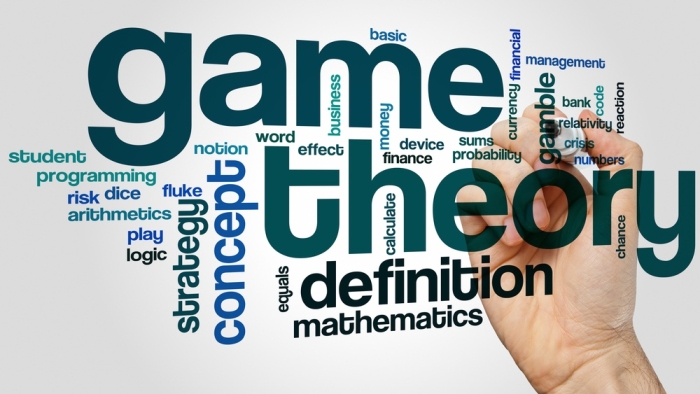These early orders enhanced Airbus’ commitment to enter the long-haul aircraft market, which till then had been dominated by Boeing. Why was the commitment important? Boeing would prefer to prevent competition by Airbus. However, the commitment by Airbus meant that any action by Boeing to keep Airbus out of the market would be futile. In this note, with the help of simple game theory, I will explain how firms can use commitment to their advantage.
Consider the game between firms 1 and 2 that is shown in the following table. Each firm decides whether to charge a low price (L) or a high price (H). Given the chosen prices, they realize profits as specified in the table. For example, if firm 1 chooses L, while firm 2 chooses H, then the profits of firms 1 and 2 are 25 and 11, respectively.
|
|
|
Firm 2 |
|
|
|
|
L |
H |
|
Firm 1 |
L |
15,12 |
25,11 |
|
|
H |
10,13 |
20,14 |
What prices do we expect the firms to choose in this game? The profit of firm 1 is either 15 or 25 if it chooses L, while its profit is either 10 or 20 if it chooses H. Although ultimately its profit also depends on the price chosen by firm 2, we see that the profit from choosing L is always higher than the corresponding profit from choosing H. Therefore, it is optimal for firm 1 to choose L. But if firm 1 chooses L, then firm 2 will also choose L and get a profit of 12 instead of 11 if it chose H. To summarize, both firms choose L, firm 1 earns 15, and firm 2 earns 12.
Could firm 1 do better? It would, of course, prefer the outcome where its profit is 25, that is, when it chooses L and firm 2 chooses H. However, we already argued that if firm 1 chooses L, it is not optimal for firm 2 to choose H. Still, firm 1 could increase its profit if it was able to commit to price H. If it commits to H, then firm 2 also finds it optimal to choose H: H gives 14, while L gives 13. As a result, the profit of firm 1 is 20, which is more than if both firms choose L.
For the commitment to work, it must satisfy two conditions. First, commitment must be visible and understandable to other firms. In the above game, if firm 2 continues to choose L, then firm 1, by committing to H, actually loses because its profit would be reduced to 10. Firm 1 benefits by committing to H exactly because it alters the behaviour of firm 2: the latter now also wants to choose H. But for it to work, firm 2 must know that firm 1 has committed to H.
How can firm 1 acquire credibility? If possible, it could adopt a type of burning-bridges-behind-you policy which would limit its own freedom of choice by eliminating the option to choose L. However, it is also enough if prior to deciding on the price, firm 1 takes actions which make choosing L less attractive. For instance, it can build reputation for always charging H and it would suffer a loss of reputation, say, worth 10 if it ever chooses L. This effectively transforms the game into the following one:
|
|
|
Firm 2 |
|
|
|
|
L |
H |
|
Firm 1 |
L |
5,12 |
15,11 |
|
|
H |
10,13 |
20,14 |
Now, the profit from choosing H is always higher than the corresponding profit from choosing L (10 vs. 5 and 20 vs. 15). Therefore, firm 1 will indeed have incentives to choose H.
Alternatively, firm 1 can take actions which raise its profit when choosing price H. As an example, suppose that before deciding on the price, firm 1 spends on an advertising campaign, which increases its (gross) profit from H as shown in the following table:
|
|
|
Firm 2 |
|
|
|
|
L |
H |
|
Firm 1 |
L |
15,12 |
25,11 |
|
|
H |
17,13 |
27,14 |
The profit from choosing H is now again higher than the corresponding profit from choosing L (17 vs. 15 and 27 vs. 25). Therefore, firm 1 will choose H. However, advertising is costly, and we also need to take this cost into account. If the advertising cost is equal to 9, then the net profit of firm 1 is 27-9=18, which is still more than 15 that it would obtain if it did not advertise.
In this last example, the decision to advertise is known as a strategic decision because it is aimed at altering how the game will be played. We can distinguish between the direct effect and the strategic (or indirect) effect of the strategic decision. The direct effect measures the change in the net profit of firm 1 assuming that the price of firm 2 remains L. In the example, the direct effect is negative because the profit of firm 1 is reduced from 15 to 17-9=8. The strategic effect takes into account how the commitment affects the behaviour of firm 2. Because firm 2 chooses H instead of L, firm 1 additionally earns 27-17=10. That is, the strategic effect is positive, and it more than outweighs the negative direct effect.
We can easily construct an example where the direct effect is positive while the strategic effect is negative. Suppose that the advertising, which now costs 14, results in the following (gross) profits:
|
|
|
Firm 2 |
|
|
|
|
L |
H |
|
Firm 1 |
L |
15,12 |
25,11 |
|
|
H |
32,13 |
27,14 |
Clearly, with these profits, it is again optimal for both firms to choose H. Now, the direct effect for firm 1 is positive because its profit increases by 3 from 15 to 32-14=18. The strategic effect, however, is negative: 27-32=-5. The overall effect is also negative: 3-5=-2. We conclude that in this case, firm 1 does not benefit from committing to price H.
The main lesson from the last two examples is that a firm when making a strategic decision, must not only look at its direct effect, but it should also anticipate how the decision will affect the behaviour of its rivals. If the positive strategic effect outweighs the negative direct effect, the firm should adopt the commitment. On the contrary, if the negative strategic effect outweighs the positive direct effect, the firm should abstain from making the commitment.
The final point to make is that the decision whether to commit depends on the market details. In the above examples, by committing to H, firm 1 induces firm 2 also to choose H. The interpretation is that the commitment relaxes the competition in the market, which allows both firms to earn higher profits. If, on the contrary, firm 2 is a potential entrant, then firm 1 might prefer to choose price L because it keeps firm 2 out of the market. To see it, suppose that firm 2 must incur a cost of 13 to enter the market. The entry will not be profitable if post entry it expects both firms to choose L, which gives it a gross profit of 12 (and a negative net profit of 12-13=-1), while the entry would be profitable if it expects both firms to choose H, which gives it a gross profit of 14.
One can read more about commitment in chapter 9 of Besanko et al. (2010) and in chapters 5 and 6 of Dixit and Nalebuff (1991).
References
Besanko. D., D. Dranove, M. Shanley, and S. Schaefer. Economics of Strategy. John Wiley & Sons, 2010.
Dixit, A., and B. Nalebuff. Thinking Strategically: The Competitive Edge in Business, Politics, and Everyday Life. W. W. Norton & Company, 1991.









